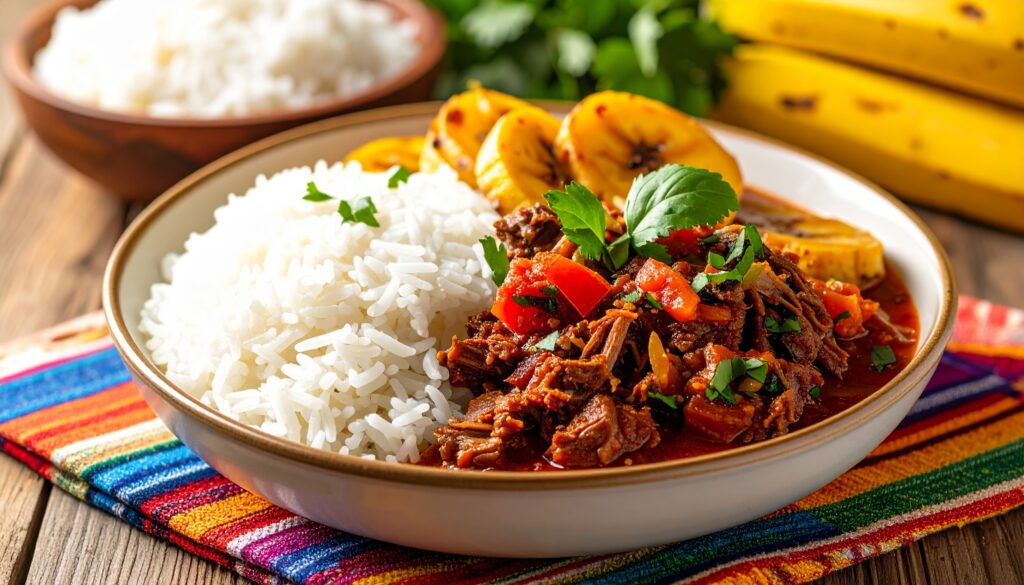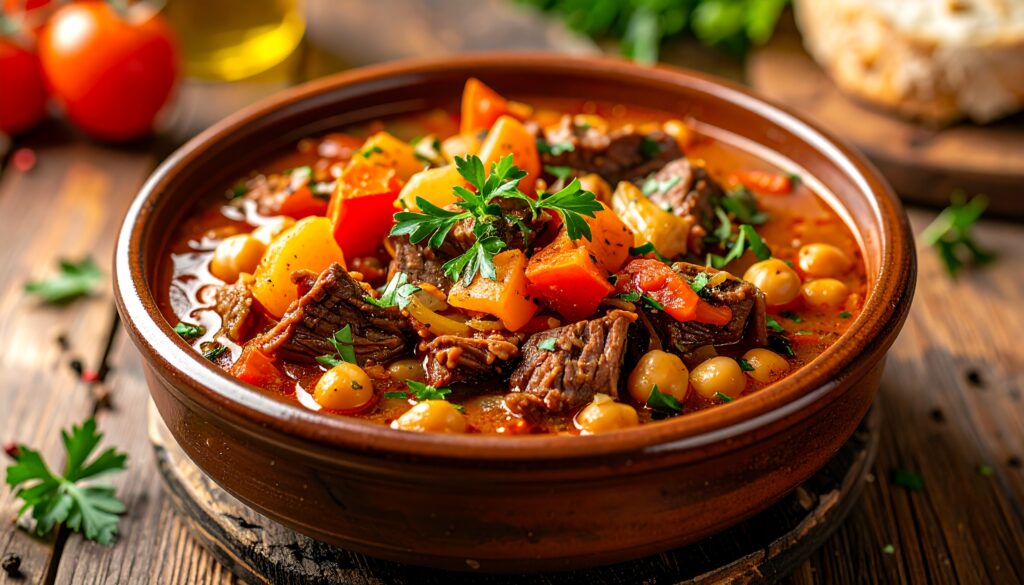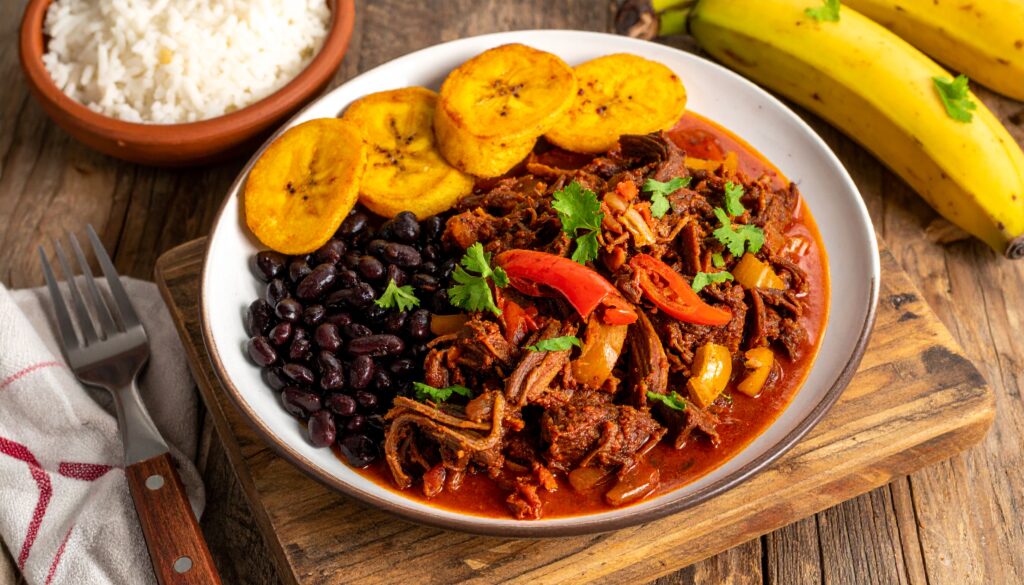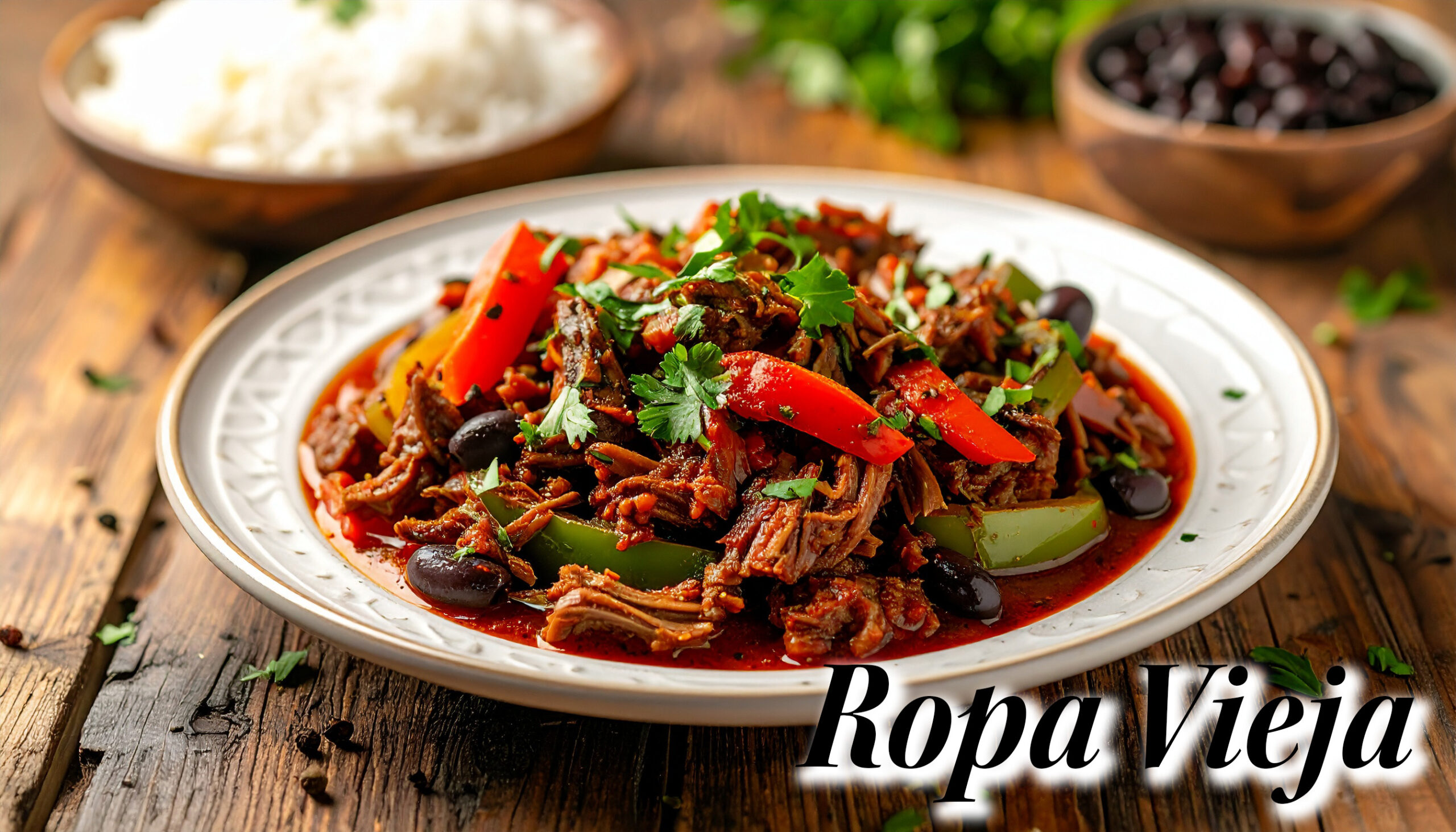Have you heard of a dish called Ropi Vieja?
This dish is a traditional favorite primarily enjoyed in Cuba!
The rich flavor of the sauce, primarily made with beef and tomato sauce, is its appeal.
This time, we'll introduce the history and production methods of Ropa Vieja!
Please enjoy it all the way to the end!
What is Lopa Vieja?

Ropa Vieja is a traditional Cuban dish.
Finely shredded beef is simmered in tomato sauce and served with white rice, simmered black beans, fried bananas, and other accompaniments.
This dish combines the cheerful spiciness characteristic of Latin America with a gentle, home-style umami flavor.
Its flavor is rich, characterized by the deep, savory richness and aromatic depth of a tomato sauce base.
Ropa Vieja is a signature dish of Cuba, but it is also widely enjoyed throughout the Caribbean and Latin America.
- Canary Islands, Spain: There is a base dish to which chickpeas are added.
- Puerto Rico: Features abundant tomatoes and olives, with a tangy flavor and pronounced herbaceous aroma.
- Venezuela: A similar dish is “Carne Mechada.”
It is also typically eaten with arepas.
The name originates from the Spanish word meaning “secondhand clothing.”
It was named because the appearance of the thinly shredded meat resembles scraps of old fabric.
In Cuba itself, it is regarded as “Sunday home cooking” or “a special feast for special occasions.”
The History of Lopa Vieja

The origins of this dish are believed to be connected to the culinary traditions of the Sephardic Jews who resided on the Iberian Peninsula in Spain.
For example, in Judaism, there is a special day called the Sabbath (Shabbat) observed once a week for rest and prayer.
On this day, Jews avoid “labor” such as work or using fire, spending time with family and engaging in worship.
Meals must also be prepared in advance.
Therefore, the custom of preparing stewed dishes the day before came about.
This is considered one of the origins of “long-simmered dishes” like Ropa Vieja.
Additionally, it is said that in Spain's Canary Islands, there was a tradition of using leftovers from a stew called “cocido” to prepare another dish called “ropa vieja.”
In other words, its origins as a dish are believed to lie in Spain, with the Canary Islands being one of its places of origin.
Fun Facts and Interesting Stories About Lopa Vieja
A Mysterious Legend ― “The Story of the Father Who Boiled His Clothes”
Jewish folk tales remain in Lopa Vieja.
Long ago, a poor father, unable to provide food for his hungry family, lovingly prayed while simmering old clothes in a pot. It is said that they transformed into a real meat stew.
This story has been passed down as a symbol of faith and love.
There is also a theory that this legend is the origin of the dish name “Ropa Vieja” (Old Clothes).
One of Cuba's national dishes
In Cuba, Ropa Vieja is known as the “national dish.”
It's a staple menu item at restaurants and is often prepared at home for special occasions.
In times when beef was scarce, it was sometimes made with goat or pork instead.
In Spain's Canary Islands, it's a different story.

There is also a dish called “Lopa Vieja” in Spain's Canary Islands, which is a stew containing chickpeas, potatoes, chicken, and other ingredients.
Even though the name is the same, the taste is quite different from the Cuban version.
In other words, while the name “Ropa Vieja” is widely used throughout the Spanish-speaking world, its contents differ from country to country.
Common features with stewed shredded meat dishes around the world

Ropa Vieja is very similar to other “shredded meat stews” around the world.
For example:
- Carne Mechada from Venezuela
- Barbacoa in Mexico
- Southern-style Pulled Beef
Both share the common cooking method of “simmering thoroughly until the fibers separate,” reflecting cultural exchange.
Lopa Vieja Day
In fact, there is a movement within American and Cuban communities to celebrate March 8th as “National Ropa Vieja Day.”
This is not an official international day, but it sometimes becomes a topic of discussion on social media.
How to Make Ropa Vieja
Ingredients (serves 4)
〈For Parboiling Beef〉
- Beef brisket (or chuck roast) ... 500g
- Water...1L
- Onion (1/2 onion, roughly chopped) ... 1 onion
- Garlic... 2 cloves
- Salt... 1 teaspoon
- Bay leaf...1
〈Simmered Sauce〉
- Olive oil... 2 tablespoons
- Onion (thinly sliced)・・・1
- Bell peppers (1 red, 1 green, thinly sliced) ... 2 peppers
- Garlic (minced) ... 2 cloves
- Canned tomatoes (chopped)・・・400g
- Tomato paste... 1 tablespoon
- Cumin powder... 1 teaspoon
- Paprika powder... 1 teaspoon
- Oregano... 1/2 teaspoon
- Salt and black pepper... to taste
- White wine (or water) ... 100ml
- Olives (sliced) ... 2 tablespoons (to taste)
- Pimentos (pickled red bell peppers / for color) ... a little
〈Finishing〉
- Parsley (finely chopped) ... to taste
- White rice... for the number of people
How to make them
- Parboil and shred the beef
Place the beef in a pot, add the onion, garlic, bay leaf, and salt, then simmer for about 1 hour.
Once the meat is tender, remove it and shred it finely along the grain using a fork.
Reserve a little of the cooking liquid for later use in the stew. - Sauté the vegetables (make the sofrito)
Heat olive oil in a frying pan and sauté the onion, bell pepper, and garlic.
Once the onion softens, add the cumin, paprika, and oregano to release their aroma. - Simmer in tomato sauce
Add canned tomatoes, tomato paste, white wine, and a small amount of the cooking liquid. Simmer over medium heat for about 10 minutes. - Return the beef and simmer until reduced
Add the shredded beef to the sauce and simmer over low heat for 20 to 30 minutes.
If the liquid is low, add some of the cooking liquid and_ season with salt and_ pepper to taste. - Finishing
Finally, add the olives and pimentos, stir gently, and serve on a plate.
Garnish with parsley and serve with white rice, black beans, and fried bananas.
Points
- Meat becomes tender and flaky when simmered for a long time. How you shred it changes the texture.
- When sautéing cumin and paprika, avoid burning them to bring out their aroma more effectively.
- Adjust the thickness of the tomato sauce to your liking (it changes depending on how long you simmer it).
Summary
How was it?
This time, we introduced Ropa Vieja, a dish widely enjoyed throughout Cuba and beyond.
The rich umami from slow-cooked beef, the depth of tomato sauce, and the harmonious blend of spices create a simple yet profoundly satisfying flavor!
One of the charms of this dish is that its style varies slightly from country to country and region to region!
So, can you eat Ropa Vieja in Japan?
I did a quick search, and it seems to be served at Latin/Cuban restaurants.
However, it's relatively rare even within this genre, so some stores might not carry it.
Checking beforehand will help you eat smartly.
Also, as usual, this article includes a recipe!
It pairs well with plain white rice, has a homey feel, and I think it's a dish that suits the Japanese palate.
Please enjoy it at home too!
Thank you for watching until the very end!
Feel free to check out our other articles too!



Comment